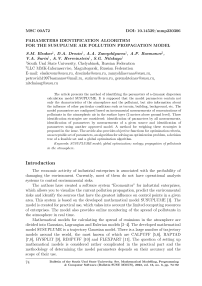Parameters identification algorithm for the SUSUPLUME air pollution propagation model
Автор: Elsakov S.M., Drozin D.A., Zamyshlyaeva A.A., Basmanov A.P., Surin V.A., Herreinstein A.V., Nitskaya S.G.
Рубрика: Краткие сообщения
Статья в выпуске: 3 т.16, 2023 года.
Бесплатный доступ
The article presents the method of identifying the parameters of a dynamic dispersion calculation model SUSUPLUME. It is supposed that the model parameters contain not only the characteristics of the atmosphere and the pollutant, but also information about the influence of other particular conditions such as terrain, building, background, etc. The model parameters are configured based on instrumental measurements of concentrations of pollutants in the atmospheric air in the surface layer (2 meters above ground level). Three identification strategies are considered: identification of parameters by all measurements, identification of parameters by measurements of a given source and identification of parameters using another approved model. A method for weighing these strategies is proposed in the issue. The article also provides objective functions for optimization criteria, an acceptable set of parameters, an algorithm for solving an optimization problem, a decision tree of a feasible set and a global optimization algorithm.
Susuplume model, global optimization, ecology, propagation of pollutants in the atmosphere
Короткий адрес: https://sciup.org/147241747
IDR: 147241747 | УДК: 004.942 | DOI: 10.14529/mmp230306
Список литературы Parameters identification algorithm for the SUSUPLUME air pollution propagation model
- Elsakov S.M., Drozin D.A., Herreinstein A.V., Krupnova T.G., Nitskaya S.G., Olenchikova T.Yu., Zamyshlyaeva A.A. Numerical Study of the Susuplume Air Pollution Model. Bulletin of the South Ural State University. Series: Mathematical Modelling, Programming and Computer Software, 2020, vol. 13, no. 4, pp. 5-18. DOI: 10.14529/mmp200401
- Leelossy A., Molnar F.Jr., Izsak F., Havasi A., Lagzi I., Meszaros R. Dispersion Modeling of Air Pollutants in the Atmosphere: a Review. Central European Journal of Geosciences, 2014, vol. 6, no. 3, pp. 257-278. DOI: 10.2478/s13533-012-0188-6
- Yao Rentai. Atmospheric Dispersion of Radioactive Material in Radiological Risk Assessment and Emergency Response. Progress in NUCLEAR SCIENCE and TECHNOLOGY, 2011, vol. 1, pp. 7-13. DOI: 10.15669/pnst.1.7
- Belov I.V., Bespalov M.S., Klochkova L.V., Pavlova N.K., Suzan D.V., Jishkin V.F. Comparative Analysis of Models of Pollutions Spreading in Atmosphere. Mathematical Modeling, 1999, vol. 11, no. 8, pp. 52-64.
- Ghannam K., El-Fadel M. Emissions Characterization and Regulatory Compliance at an Industrial Complex: An Integrated MM5/CALPUFF Approach. Atmospheric Environment, 2013, vol. 69, pp. 156-169. DOI: 10.1016/j.atmosenv.2012.12.022
- Rzeszutek M. Parameterization and Evaluation of the CALMET/CALPUFF Model System in Near-Field and Complex Terrain - Terrain Data, Grid Resolution and Terrain Adjustment Method. Science of the Total Environment, 2019, vol. 689, pp. 31-46. DOI: 10.1016/j.scitotenv.2019.06.379
- Ge Wang., Ostoja-Starzewski M. Influence of Topography on the Phoenix CO2 Dome: a Computational Study. Atmospheric Science Letters, 2004, vol. 5, no. 5, pp. 103-107. DOI: 10.1002/asl.67
- Jay Wu., Chung-Hsin Lu., Shu-Jun Chang., Yung-Muh Yang., Bor-Jing Chang., Jen-Hsin Teng. Three-Dimensional Dose Evaluation System using Real-Time Wind Field Information for Nuclear Accidents in Taiwan. Nuclear Instruments and Methods in Physics Research Section A: Accelerators, Spectrometers, Detectors and Associated Equipment, 2006, vol. 565, no. 2, pp. 812-820. DOI: 10.1016/j.nima.2006.05.197
- McGowan H., Clark A. Identification of Dust Transport Pathways from Lake Eyre, Australia using Hysplit. Atmospheric Environment, 2008, vol. 42, pp. 6915-6925. DOI: 10.1016/j.atmosenv.2008.05.053
- Lepicard S., Heling R., Maderich V. POSEIDON/RODOS Models for Radiological Assessment of Marine Environment after Accidental Releases: Application to Coastal Areas of the Baltic, Black and North Seas. Journal of Environmental Radioactivity, 2004, vol. 72, no. 1-2, pp. 153-161. DOI: 10.1016/S0265-931X(03)00197-8
- Stohl A., Hittenberger M., Wotawa G. Validation of the Lagrangian Particle Dispersion Model Flexpart Against Large-Scale Tracer Experiment Data. Atmospheric Environment, 1998, vol. 32, no. 24, pp. 4245-4264. DOI: 10.1016/S1352-2310(98)00184-8
- Powell M.J.D. The BOBYQA Algorithm for Bound Constrained Optimization without Derivatives. Centre for Mathematical Sciences. Report DAMTP, 2009, no. NA06, 39 p.


